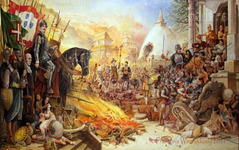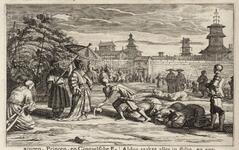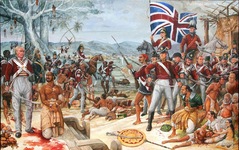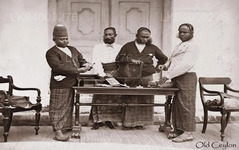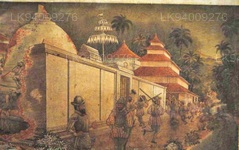Portuguese Period
By about 1500 trade in the Indian Ocean was dominated by Arab, Indian, Malay, and Chinese merchants, who together used various seafaring craft to transport a spectrum of cargo, from spices to elephants. In the early 16th century a new force, in the form of Portuguese ships with mounted guns, arrived in the ocean. These vessels, with their firepower and capacity for high speeds, helped implement a policy of control that began to undermine the region’s long-standing, relatively open trade competition. In 1505 a Portuguese fleet commanded by Lourenço de Almeida was blown into Colombo by adverse winds. Almeida received a friendly audience from the king of Kotte, Vira Parakrama Bahu, and was favourably impressed with the commercial and strategic value of the island. The Portuguese soon returned and established a regular and formal contact with Kotte. In 1518 they were permitted to build a fort at Colombo and were given trading concessions.
In 1521 three sons of Vijayabahu, the reigning king of Kotte, put their father to death and partitioned the kingdom among themselves. The eldest of the brothers, Bhuvanaika Bahu, ruled at Kotte, and the two others set up independent kingdoms at Sitawake and Rayigama. Mayadunne, the king of Sitawake, was an ambitious and able ruler who sought to expand his frontiers at the expense of his brother at Kotte. Bhuvanaika Bahu could not resist the temptation of seeking Portuguese assistance, and the Portuguese were eager to help him. The more he was pressed by Mayadunne, the greater was his reliance on Portuguese reinforcement. Bhuvanaika Bahu defended his kingdom against Mayadunne, who in turn allied himself with an inveterate enemy of the Europeans, the zamorin (member of the Zamorin dynasty) of Kozhikode (also known as Calicut, in southwestern India).
Bhuvanaika Bahu was succeeded by his grandson Prince Dharmapala, who was even more dependent on Portuguese support. An agreement between Bhuvanaika Bahu and the king of Portugal in 1543 had guaranteed the protection of the prince on the throne and the defense of the kingdom; in return the Portuguese were to be confirmed in all their privileges and were to receive a tribute of cinnamon. The prince was educated by members of the Franciscan order of the Roman Catholic Church; in 1556 or 1557, when his conversion to Christianity was announced, he became easily controlled by the Portuguese. Dharmapala’s conversion undermined the Kotte dynasty in the eyes of the people. Mayadunne’s wars of aggression were now transformed into a struggle against Portuguese influence and interests in the island, and he annexed a large part of the Kotte kingdom. After Mayadunne’s death, his son Rajasinha continued these wars successfully on land, though, like his father, he had no way of combating Portuguese sea power. At the death of Rajasinha in 1593, the Sitawake kingdom disintegrated for want of a strong successor. The Portuguese captured much of the land of the Kotte royal lineage and emerged as a strong power on the island. In 1580 Dharmapala had been persuaded to deed his kingdom to the Portuguese, and when he died in 1597 they took formal possession of it. Meanwhile, a Portuguese expedition to Jaffna in 1560 had no lasting success. A second invasion of 1591, undertaken at the instigation of Christian missionaries, succeeded in installing a Portuguese protégé. Continued unrest and succession disputes prompted the Portuguese to undertake a third expedition, and the kingdom of Jaffna was annexed in 1619.
The Portuguese now controlled a considerable part of the island, except the Central Highlands and eastern coast, where an able Sinhalese nobleman, Vimala Dharma Surya, had established himself and consolidated his authority. The Portuguese were eager to establish hegemony over the entire island, and their attempts to do so led to protracted warfare. The Portuguese expanded to the lower reaches of the Central Highlands and annexed the east coast ports of Trincomalee and Batticaloa. Although Portuguese possessions in Sri Lanka became a part of the Portuguese Estado da India (State of India), the administrative structure of the Kotte kingdom was retained. The island was divided into four dissavanis, or provinces, each headed by a dissava. Other territorial subdivisions also were retained. Portuguese held the highest offices, though local officials came from the Sinhalese nobility loyal to the Portuguese. The Sinhalese system of service tenure was maintained, and it was used extensively to secure the essential produce of the land, such as cinnamon and elephants. The caste system remained intact, and all obligations that had been due to the sovereign now accrued to the Portuguese state. The payment in land to officials also was continued and was extended to Portuguese officials as well. The Portuguese generally lacked a proper understanding of traditional Sinhalese social and economic structure, and excessive demands put upon it led to hardship and popular hostility. Cinnamon and elephants became articles of Portuguese monopoly; they provided good profits, as did the trade in pepper and betel nuts (areca nuts). Portuguese officials compiled a tombo, or land register, to provide a detailed statement of landholding, crops grown, tax obligations, and nature of ownership.
The period of Portuguese influence was marked by intense Roman Catholic missionary activity. Franciscans established centres in the country from 1543 onward. Jesuits were active in the north. Toward the end of the century, Dominicans and Augustinians arrived. With the conversion of Dharmapala, many members of the Sinhalese nobility followed suit. Dharmapala endowed missionary orders lavishly, often from the properties of Buddhist and Hindu temples. After the Portuguese secured control of Sri Lanka, they used their extensive powers of patronage and preference in appointments to promote Christianity. Members of the landed aristocracy embraced Christianity and took Portuguese surnames at baptism. Many coastal communities underwent mass conversion, particularly Jaffna, Mannar, and the fishing communities north of Colombo. Catholic churches with schools attached to them served Catholic communities all over the country. The Portuguese language spread extensively, and the upper classes quickly gained proficiency in it.
Kandy and its struggle with European powers
Rajasinha occupied Kandy, a Sinhalese kingdom in the Central Highlands, about 1580, and its ruler took refuge with the Portuguese. In 1591 the Portuguese launched an expedition to Kandy to enthrone Dom Philip, an heir of the dispossessed ruler. They were accompanied by an ambitious and distinguished Sinhalese military nobleman, Konnappu Bandara. Dom Philip was installed as king but died under suspicious circumstances, and Konnappu Bandara enthroned himself, proclaiming independence from the Portuguese and taking the regnal name of Vimala Dharma Surya. The demise of Sitawake after Rajasinha’s death left Kandy the only independent Sinhalese kingdom. The Portuguese launched another expedition to Kandy, in 1594, under Gen. Pedro Lopes de Sousa, planning to enthrone Dona Catherina, a baptized Sinhalese noblewoman. Popular hostility soon built up toward the seemingly ever-present Portuguese troops. Vimala Dharma Surya took advantage of the agitated atmosphere and, making use of guerrilla warfare tactics, routed the Portuguese army in 1594. He captured Dona Catherina, made her his queen, and legitimized and consolidated his rule. He expanded into the old Sitawake kingdom and emerged as the leader of resistance to the Portuguese. The Portuguese made a few subsequent attempts to subjugate Kandy, but none were successful.
Vimala Dharma Surya realized that without sea power he could not drive the Portuguese out of Sri Lanka. He saw the arrival of the Dutch as an excellent opportunity to gain naval support against his adversaries. The first Dutch envoy, Joris van Spilbergen, met the king in July 1602 and made lavish promises of military assistance. A few months later another Dutch official, Sebald de Weert, arrived with a concrete offer of help and, in view of favourable terms offered by the king, decided to launch a joint attack on the Portuguese. However, a misunderstanding between the king and de Weert caused an altercation between the Kandyans and the Dutch, and de Weert and his men were killed. King Senarath (Senarat) succeeded to the Kandyan throne in 1604 and continued to solicit Dutch support. In 1612 a Dutch envoy, Marcelis Boschouwer, concluded a treaty with Senarath. The king granted the Dutch extensive commercial concessions and a harbour for settlement on the east coast in return for a promise of armed assistance against Portuguese attack. The Dutch ultimately were unable to offer adequate assistance, and so Senarath turned to the Danes. By the time a Danish expedition arrived in May 1620, however, Senarath had concluded a peace agreement with the Portuguese. The truce was short-lived, and in 1630 the Kandyans, taking the offensive, invaded Portuguese territory and laid siege to Colombo and Galle. Again the absence of sea power proved a handicap, and another peace was concluded in 1634.
In 1635 Senarath was succeeded by his son Rajasinha II. The Dutch were now firmly established in Batavia (now Jakarta) in Java and were developing their trade in southern Asia. The king sent emissaries to meet the admiral of the Dutch fleet, Adam Westerwolt, who was then blockading Goa, India. The fleet came to Sri Lanka and captured Batticaloa. Westerwolt and Rajasinha II concluded a treaty on May 23, 1638, giving the Dutch a monopoly on most of Sri Lanka’s cinnamon and a repayment in merchandise for expenses incurred in assisting the king. In May 1639 the Dutch fleet captured Trincomalee, and in February 1640 the Dutch and the Kandyans combined to take Negombo. But differences arose over the occupation of captured forts. The Dutch refused to give Trincomalee and Batticaloa to the king until their expenses were paid in full, and Rajasinha II realized that what the Dutch really wanted was to replace the Portuguese as the rulers of the coast.
Rajasinha II nevertheless continued to work with the Dutch to expel the Portuguese. In March 1640 Galle was taken, but the progress of the allies soon was temporarily halted by a truce declared in Europe between the Dutch Republic and Spain, which at that time ruled Portugal and its overseas possessions. In 1645 the boundaries between Portuguese and Dutch territory in Sri Lanka were demarcated. Jan Thijssen was appointed the first Dutch governor. The Dutch peace with the Portuguese and occupation of captured territory incensed the Kandyan king and strained relations between him and the Dutch. In May 1645 war broke out between them. Though Rajasinha II could not conquer the occupied lands, he made them worthless to the Dutch by destroying crops and depopulating villages. The Dutch then realized the advantage of coming to terms with the king. In 1649 a revised treaty was signed. The Dutch agreed to hand over some of the lands but again delayed it because of the immense debt the king was held to owe them.
The Dutch truce with the Portuguese expired in 1652, leaving the Dutch free to resume the war. Kandyans launched attacks on Portuguese positions in the interior provinces of Seven Korales, Four Korales, and Sabaragamuwa and pushed the Portuguese back to their coastal strongholds, despite fierce resistance. Rajasinha II was anxious to attack Colombo, but he was put off by the Dutch. He tried to secure guarantees from them for the return of that city after its conquest, and the Dutch made lavish promises. In August 1655 the Dutch were strengthened by the arrival of a large fleet under Gen. Gerard Hulft, and they laid siege to Colombo by sea and by land. In May 1656 the Portuguese surrendered the city to the Dutch, who shut the Kandyans out of its gates. Requests for the cession of Colombo met with evasive replies. Highly incensed, Rajasinha II destroyed the lands around Colombo, removed its inhabitants, and withdrew to his mountain kingdom.
After a brief respite the Dutch resumed the expulsion of the Portuguese from Sri Lanka. Adm. Ryckloff van Goens arrived with a fleet to continue the attack on Portuguese strongholds in northern Sri Lanka. The Dutch took Mannar in February 1658 and Jaffna in June. They had replaced the Portuguese as masters of coastal Sri Lanka.

